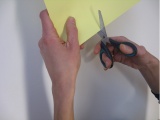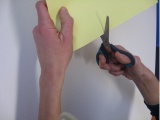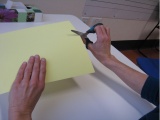Simple craftwork usually consists of three steps:
-
Step 1: Tearing out or cutting out pieces of paper
-
Step 2: Gluing the pieces
-
Step 3: Placing the pieces in the right way
When craftwork projects require cutting out paper, your child has to be able to correctly hold a pair of scissors in one hand while holding the paper steady with the other (use construction paper instead of a flimsy loose-leaf). Keep in mind that there are scissors for both left- and right-handed individuals.
The following are some functional and non-functional ways of gripping scissors
Functional scissor grasp (achieved at the age of 3 years)


Note that both thumbs have to be positioned on top of the paper to cut. This position is required in order for the child to hold the paper in a steady manner.
Non-functional grasp (to correct)

If your child has trouble facing their thumbs upward, put stickers on their thumb nails that they can use as visual reminders.
The following are some tips you can use to improve your child’s coordination patterns when doing craftwork:
-
Keep the craftwork sample always in plain sight. This will allow your child to better understand the task at hand.
-
Show your child how to apply glue. Ask them to tear out or cut out pieces of paper to glue on a separate sheet of paper.
-
Show them how to apply glue on each cutout instead of directly applying it on the sheet of paper. Once your child has mastered the step of applying glue, then give them pictures to stick (ex: apples on a tree, a car on a street, etc.). For this step, they will have to learn to turn the picture over to apply the glue and then to turn it back over to be stuck in the correct position.
For more complex craftwork projects that will require your child to cut out and put two or more pieces together:
-
Place a small basket on the table next to your child in which they can put the pieces they will be gluing and to keep them separate from any leftover waste paper.
-
If your child has difficulty putting the pieces in the right place, place the sample right over their sheet of paper. Ask your child to first place the cutout on the sample and to then bring it down to place it on their own paper.
Puzzles
-
Choose a puzzle with the right number of pieces for your child so that putting it together does not become a huge challenge for them. Select puzzles that have a lot of colour contrasts.
-
Avoid having your child put the pieces together by trial and error. Instead, ask them to pick out the ones that have the same colours. Encourage them to figure out what the pictures on the pieces may be so that they can try to match them up with other pieces.
-
Do not insist that they begin by putting together the contour of the puzzle. What is important is that they develop their visual perception by finding two pieces that could be matched together.